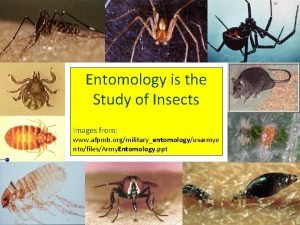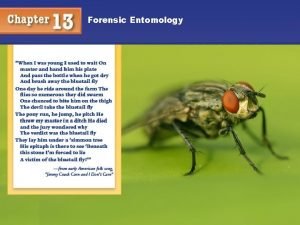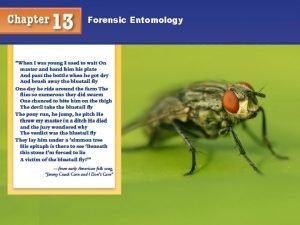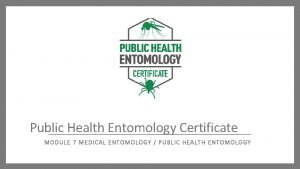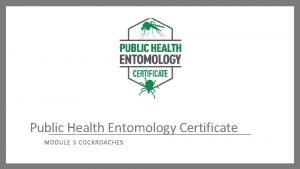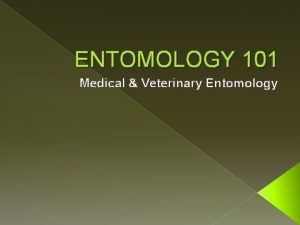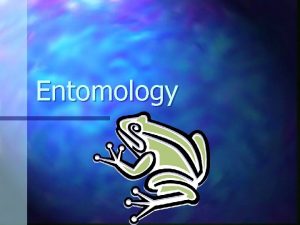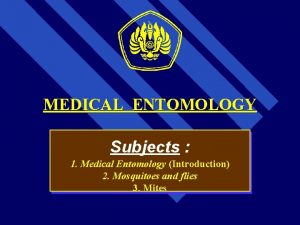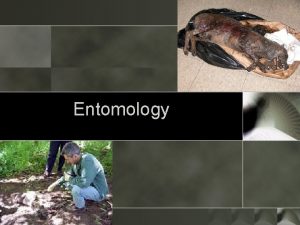Medical Entomology Medical entomology is the science dealing








- Slides: 8


Medical Entomology Medical entomology is the science dealing with arthropods that may directly cause or transmit diseases to human. General characters of arthropods : • Multicellular and bilaterally symmetrical animals. • Body is segmented. Each segment bears a jointed appendage. • Body composed of head, thorax and abdomen. • Body is covered by exoskeleton, which is made by chitin. The exoskeleton project inside, this projections are useful for muscle attachment. • Exoskeleton is cast off periodically during development and a new one is secreted in a process called molting.

• Digestive system is divided into foregut, midgut and a hindgut. The foregut is composed of esophagus, croup, proventriculus and a pair of salivary glands opening into the buccal cavity. Midgut is tubular stomach, which may have two or more ceca emerging from its anterior part. Hindgut is divided into intestine and rectum; its function is evacuating food waste as well as regulating water and ions in insect’s body. • Sexes are separate. Gonads and their ducts are paired. External genitalia of male (aedeagus and paired claspers) have a taxonomic value. Medical importance of arthropods : Arthropods can affect the health of man as following:

1 - Arthropods can act as a cause of the diseases e. g. a)Inoculation of poisons: e. g. ticks, spiders & scorpions. b)Invasion of tissues: e. g. scabies & myiasis. c)Dermatitis and allergic skin lesions: e. g. fleas, mosquitos, bugs & lice. 2 - Arthropods can transmit the diseases to man by: a- Their ingestion: As the ingestion of Cyclops infected with larvae of medina worm causing dracunculiasis and ingestion of fleas infected with cysticercoid larvae of Hymenolpis diminuta. b- Inoculation of the pathogens into the skin of man e. g. tsetse fly transmitting the trypanosomes causing trypanosomiasis and anopheles transmitting the plasmodium causing malaria.

c- Contamination of the skin of man with: - Their excreta e. g. winged bugs transmit Trypanosoma cruzi, the causative parasite of Chaga`sdisease. - Their crushed bodies e. g. Pediculus humanus transmit Borrelea recurrentis, the causative agents of epidemic relapsing fever. - Both their excreta and crushed bodies e. g. Pediculus humanus transmit Rickettsia prowazeki, the causative agents of epidemic typhus fever. 3 - Entomophobia: Sometimes, fear of insects (entomophobia) is seen in some individuals where there are symptoms of crawling or biting sensations accompanied by excessive scratching by the patient.



The following are the most common diseases transmitted by arthropods: • Dengue fever - Vectors: Aedes aegypti (main vector) • Malaria - Vectors: Anopheles mosquitoes. • Leishmaniasis - Vectors: species in the genus Lutzomyia in the New World and Phlebotomus in the Old World. • Plague - Principal vector: Xenopsylla cheopis • Sleeping sickness - Vector: Tsetse fly. • Typhus - Vectors: mites, fleas and body lice. • Wuchereria bancrofti - most common vectors: the mosquito species: Culex, Anopheles, Mansonia, and Aedes. • Yellow Fever - Principal vectors: Aedes aegypti.
